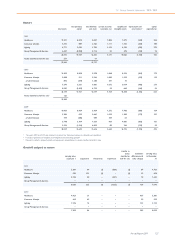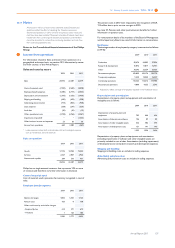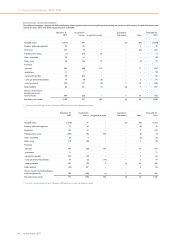Philips 2011 Annual Report Download - page 131
Download and view the complete annual report
Please find page 131 of the 2011 Philips annual report below. You can navigate through the pages in the report by either clicking on the pages listed below, or by using the keyword search tool below to find specific information within the annual report.
12 Group financial statements 12.10 - 12.10
Annual Report 2011 131
this case, the Company also recognizes an associated liability. The
transferred receivable and associated liability are measured on a basis
that reflects the rights and obligations that the Company has retained.
Other non-current financial assets
Other non-current financial assets include held-to-maturity
investments, loans and available-for-sale financial assets and financial
assets at fair value through profit or loss.
Held-to-maturity investments are those debt securities which the
Company has the ability and intent to hold until maturity. Held-to-
maturity debt investments are recorded at amortized cost, adjusted for
the amortization or accretion of premiums or discounts using the
effective interest method.
Loans receivable are stated at amortized cost, less the related
allowance for impaired loans receivable.
Available-for-sale financial assets are non-derivative financial assets that
are designated as available-for-sale and that are not classified in any of
the other categories of financial assets. Subsequent to initial
recognition, they are measured at fair value and changes therein, other
than impairment losses and foreign currency differences on available
for sale-debt instruments are recognized in other comprehensive
income and presented in the fair value reserve in equity. When an
investment is derecognized, the gain or loss accumulated in equity is
reclassified to the Statement of income.
Available-for-sale financial assets including investments in privately-
held companies that are not associates, and do not have a quoted
market price in an active market and whose fair value could not be
reliably determined, are carried at cost.
A financial asset is classified as fair value through profit or loss if it is
classified as held for trading or is designated as such upon initial
recognition. Financial assets are designated as fair value through profit
or loss if the Company manages such investments and makes purchase
and sale decisions based on their fair value in accordance with the
Company-documented risk management or investment strategy.
Attributable transaction costs are recognized in the Statement of
income as incurred. Financial assets at fair value through profit or loss
are measured at fair value, and changes therein are recognized in profit
or loss.
Share capital
Common shares are classified as equity. Incremental costs directly
attributable to the issuance of shares are recognized as a deduction
from equity. Where the Company purchases the Company’s equity
share capital (treasury shares), the consideration paid, including any
directly attributable incremental costs (net of income taxes) is
deducted from equity attributable to the Company’s equity holders
until the shares are cancelled or reissued. Where such ordinary shares
are subsequently reissued, any consideration received, net of any
directly attributable incremental transaction costs and the related
income tax effects, is included in equity attributable to the Company’s
equity holders.
Debt and other liabilities
Debt and liabilities other than provisions are stated at amortized cost.
However, loans that are hedged under a fair value hedge are
remeasured for the changes in the fair value that are attributable to the
risk that is being hedged.
Derivative financial instruments, including hedge accounting
The Company uses derivative financial instruments principally to
manage its foreign currency risks and, to a more limited extent, for
managing interest rate and commodity price risks. All derivative
financial instruments are classified as current assets or liabilities and are
accounted for at trade date. Embedded derivatives are separated from
the host contract and accounted for separately if the economic
characteristics and risks of the host contract and the embedded
derivative are not closely related. The Company measures all derivative
financial instruments based on fair values derived from market prices
of the instruments or from option pricing models, as appropriate. Gains
or losses arising from changes in fair value of derivatives are recognized
in the Statement of income, except for derivatives that are highly
effective and qualify for cash flow or net investment hedge accounting.
Changes in the fair value of derivatives that are designated and qualify
as fair value hedges are recorded in the Statement of income, together
with any changes in the fair value of the hedged asset or liability that
are attributable to the hedged risk. For interest rate swaps designated
as a fair value hedge of an interest bearing asset or liability that are
unwound, the amount of the fair value adjustment to the asset or
liability for the risk being hedged is released to the Statement of income
over the remaining life of the asset or liability based on the recalculated
effective yield.
Changes in the fair value of a derivative that is highly effective and that is
designated and qualifies as a cash flow hedge, are recorded in equity,
until the Statement of income is affected by the variability in cash flows
of the designated hedged item. To the extent that the hedge is
ineffective, changes in the fair value are recognized in the Statement of
income.
The Company formally assesses, both at the hedge’s inception and on
an ongoing basis, whether the derivatives that are used in hedging
transactions are highly effective in offsetting changes in fair values or
cash flows of hedged items. When it is established that a derivative is
not highly effective as a hedge or that it has ceased to be a highly
effective hedge, the Company discontinues hedge accounting
prospectively. When hedge accounting is discontinued because it is
expected that a forecasted transaction will not occur, the Company
continues to carry the derivative on the Balance sheet at its fair value,
and gains and losses that were accumulated in equity are recognized
immediately in the Statement of income. If there is a delay and it is
expected that the transaction will still occur, the amount in equity
remains there until the forecasted transaction affects income. In all
other situations in which hedge accounting is discontinued, the
Company continues to carry the derivative at its fair value on the
Balance sheet, and recognizes any changes in its fair value in the
Statement of income.
Foreign currency differences arising on the retranslation of a financial
liability designated as a hedge of a net investment in a foreign operation
are recognized directly as a separate component of equity through
other comprehensive income, to the extent that the hedge is effective.
To the extent that the hedge is ineffective, such differences are
recognized in the Statement of income.
Property, plant and equipment
Items of property, plant and equipment are measured at cost less
accumulated depreciation and accumulated impairment losses. The
useful lives and residual values are evaluated annually.
Assets manufactured by the Company include direct manufacturing
costs, production overheads and interest charges incurred for qualifying
assets during the construction period. Government grants are
deducted from the cost of the related asset. Depreciation is calculated
using the straight-line method over the useful life of the asset.
Depreciation of special tooling is generally also based on the straight-
line method. Gains and losses on the sale of property, plant and
equipment are included in other business income. Costs related to
repair and maintenance activities are expensed in the period in which
they are incurred unless leading to an extension of the original lifetime
or capacity.
Plant and equipment under finance leases and leasehold improvements
are amortized using the straight-line method over the shorter of the
lease term or the estimated useful life of the asset. The gain realized on
sale and operating leaseback transactions that are concluded based
upon market conditions is recognized at the time of the sale.
The Company capitalizes interest as part of the cost of assets that take a
substantial period of time to become ready for use.
Goodwill
Measurement of goodwill at initial recognition is described under ‘Basis
of consolidation’. Goodwill is subsequently measured at cost less
accumulated impairment losses. In respect of investment in associates,
the carrying amount of goodwill is included in the carrying amount of
investment, and an impairment loss on such investment is not allocated
to any asset, including goodwill, that forms part of the carrying amount
of investment in associates.
Intangible assets other than goodwill
Acquired finite-lived intangible assets are amortized using the straight-
line method over their estimated useful life. The useful lives are
evaluated annually. Patents and trademarks with a finite useful life
acquired from third parties either separately or as part of the business
























